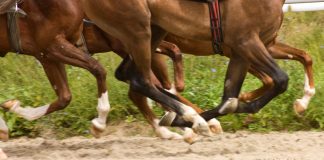Providing your horse doesn’t have a phobia about deworming, you can easily do the deed yourself. If you are unsure how to administer an anthelmintic follow our few tips:
- Since underdosing is an issue when deworming, manufacturers urge horse owners to first determine the weight of their horses. You can do that by use of a weight scale (contact your veterinarian), or if that isn’t possible, a girth measuring tape can give you a close approximation. Don’t go on height because the weight of a 16-hand Thoroughbred will be different than the weight of a 16-hand warmblood.
- Once your horse’s weight is established, look at the deworming syringe. You’ll notice that there are number marks running down the side of the tube (note: if you have a heavy horse, you may need to purchase another tube to make up the weight). Slide the latch or spin the dial until it rests on the number denoting the weight of your horse.
- Place a halter on your horse. Have a friend hold him if necessary. Make sure that your horse’s mouth is empty of all grain and hay.
- Place the syringe into the interdental space (where the bit normally sits) and point it toward the back of the tongue. Press the plunger and administer the dosage on top of the tongue. Then hold your horse’s head slightly up until he swallows.
- Watch your horse for the next five minutes or so to be sure he doesn’t spit out the medication. To further ensure that your horse has swallowed the dewormer, wait another 20 minutes before giving him anything to eat. (If the horse eats immediately after deworming, it’s easy for him to spit out part of the dewormer along with the food.
Anyone who has ever tried to deworm a horse that doesn’t care to be dewormed knows that it’s a tough task, and usually the deworm-er (you) ends up wearing most of the anthelmintic. If your horse refuses to be dewormed in the usual manner, there are alternative methods. Manufacturers have devised clever ways to make the medicine go down with palatable granules, powders or pellets that can be sprinkled on grain rations and, for the less reluctant horse, flavored paste dewormers that disguise the taste of the chemical. If you do choose to feed a granule, check to make sure your horse is eating the entire dosage and not separating the grain from the dewormer.
Further Reading
Horse Deworming Chart
Video: How to Deworm Your Horse
Deworming the Reluctant Horse
New Thinking on Deworming
Sharon Biggs is an American journalist currently based in England.






good info
great
Deworming my horse became easier by me just using something else in a syringe ie applesauce first then the dewormer.
Good article. I agree with cleaning the syringe and filling with something tasty–have you tried molasses? (I sometimes keep that to mix meds into feed so my horse cannot taste the meds. It’s been awhile since I had to do that.)
BTW, the horse afraid of a worming syringe is probably ALSO afraid of shots, so be careful! If you can relieve the fear of the worming syringe, it will help you with the other.
This is a such a helpful articale. With tips on what i need!